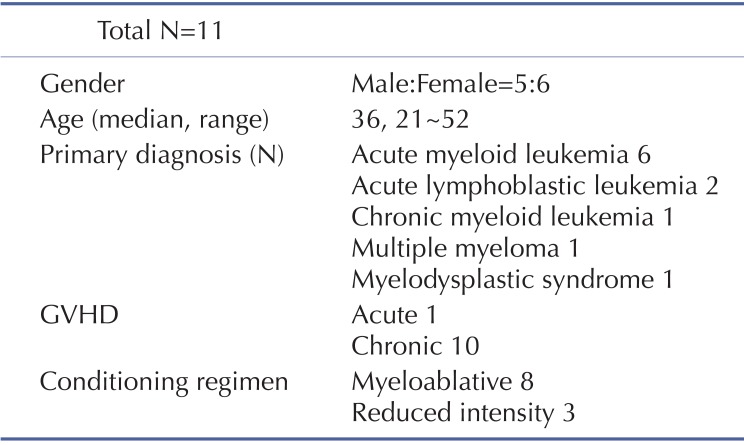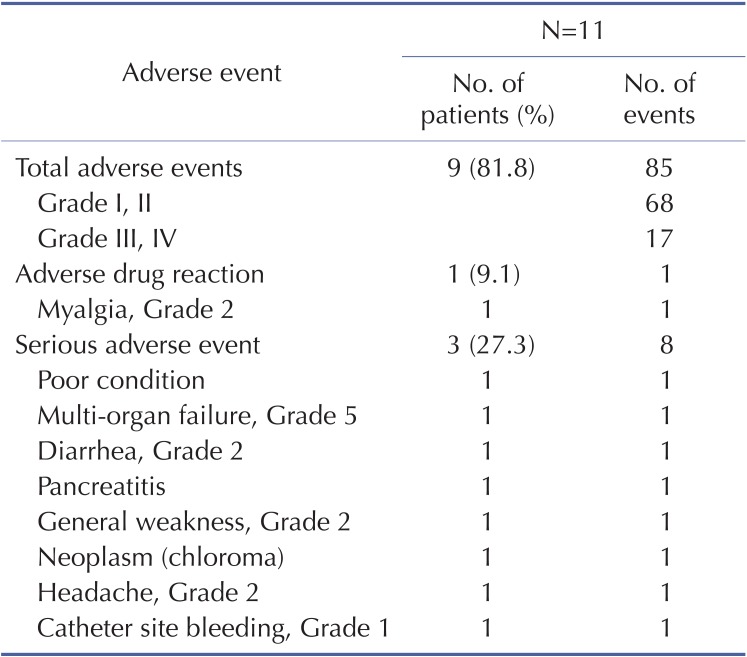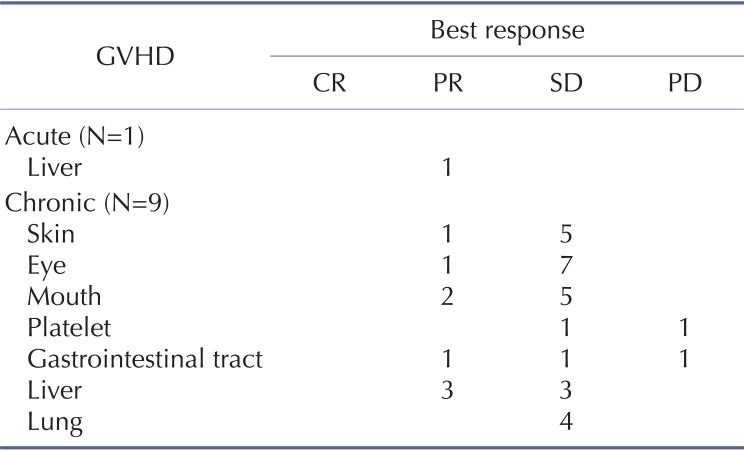Abstract
Severe graft-versus-host disease (GVHD) is an often lethal complication of allogeneic hematopoietic stem cell transplantation (HSCT). The safety of clinical-grade mesenchymal stem cells (MSCs) has been validated, but mixed results have been obtained due to heterogeneity of the MSCs. In this phase I study, the safety of bone marrow-derived homogeneous clonal MSCs (cMSCs) isolated by a new subfractionation culturing method was evaluated. cMSCs were produced in a GMP facility and intravenously administered to patients who had refractory GVHD to standard treatment resulting after allogeneic HSCT for hematologic malignancies. After administration of a single dose (1×106 cells/kg), 11 patients were evaluated for cMSC treatment safety and efficacy. During the trial, nine patients had 85 total adverse events and the rate of serious adverse events was 27.3% (3/11 patients). The only one adverse drug reaction related to cMSC administration was grade 2 myalgia in one patient. Treatment response was observed in four patients: one with acute GVHD (partial response) and three with chronic GVHD. The other chronic patients maintained stable disease during the observation period. This study demonstrates single cMSC infusion to have an acceptable safety profile and promising efficacy, suggesting that we can proceed with the next stage of the clinical trial.
Graft-versus-host disease (GVHD) is one of the major barriers limiting the success of allogeneic hematopoietic stem cell transplantation (HSCT) as a therapy for various hematologic malignancies. Steroids are used as a standard first-line treatment for GVHD; however, steroid treatment has shown sustained responses in less than 50% of patients with acute GVHD (aGVHD) and in only 40~50% of patients with chronic GVHD (cGVHD), depending on the initial disease severity [1].
Many therapeutic approaches are used in an attempt to overcome steroid-refractory GVHD, including treatment with cyclosporine, methotrexate, mycophenolate mofetil, tacrolimus, anti-thymoglobulin, as well as target agents for specific immunologic pathways related to the pathogenesis of GVHD [2]. Despite these treatments, the clinical outcome of steroid-refractory GVHD is still very poor. The reported efficacies of the abovementioned treatments are minimal, and the incidence of opportunistic infection and disease relapse has been shown to increase with such treatments [3]. The infusion of mesenchymal stem cells (MSCs) has been proposed as a promising alternative for the treatment of steroid-refractory GVHD [4], and clinical trials suggest MSCs to be beneficial to steroid-refractory GVHD patients [5678]. Clinical trials have, however, generated mixed clinical outcomes regarding the efficacy of MSC products [910]. A possible reason for these mixed results is heterogeneity in the final MSC products used: due to a lack of MSC-specificity in the current MSC isolation methods, the final MSC products produced by conventional methods may consist of heterogeneous cell populations. Maximizing the homogeneity of the final stem cell products by the use of clonal populations of MSCs as starting cell materials maybe a means of overcoming the limitation associated with current MSC products.
To obtain a clonal population of MSCs, we previously developed a new isolation method, termed the subfractionation culturing method (SCM), to produce clonal MSCs (cMSCs) from relatively small amounts of bone marrow aspirates [11]. Like MSCs isolated by the conventional gradient centrifugation method, the cMSCs isolated by the SCM were shown to possess stem cell characteristics [11].
We previously reported on pilot cases of two patients with steroid-refractory GVHD who were successfully treated with cMSC products [12]; therefore, we conducted a phase I study to determine the short-term (5 weeks) safety profile of intravenous cMSC administration in GVHD patients who were not responsive to standard treatment.
During the period from November 2010 to December 2011, 11 patients with refractory GVHD to standard treatment were enrolled in a phase I trial using third party-derived bone marrow cMSCs for the treatment of GVHD. The protocol was performed with the approval of the Korean Food & Drug Administration and the institutional review board of each institution. This study was registered at the official NIH site (www.clinicaltrials.gov) under the number NCTNCT01318330. The eligibility requirements of the study stipulated that acute or chronic GVHD patients over the age of 18 years with any grade of GVHD (grade I~IV) could be included in the trial.
The third-party cMSCs used in this study were obtained using the SCM method by which cells from single-cell-derived colonies are expanded and cultured [11]. A master cell bank and a working cell bank were established for storage, allowing for the preparation of sufficient cell numbers for treatment as soon as they were needed by a patient. cMSCs were administered intravenously (1.0×106 cells/kg) to all eligible patients within 4 weeks of patient enrollment, after which patients' vital signs were tested and symptoms were monitored.
This study is a multicenter, open-label, single-group, phase I trial conducted to evaluate the safety of intravenously administered cMSCs. After informed consent was obtained from patients, a run-in period (4 weeks) of patient screening was carried out. From the time of cMSC administration, the safety information listed in the study protocol as well as efficacy variables including changes in GVHD clinical response, overall survival, and relapse-free survival were determined. The safety and efficacy was evaluated up to 5 weeks post infusion. Grading and response criteria of acute GVHD were assessed using the 1994 consensus conference on acute GVHD grading and chronic GVHD guidelines put forth by the National Institutes of Health Consensus Development Project on Criteria for Clinical Trials [1314].
Descriptive statistics were used to analyze the demographic, efficacy, and safety data. Mean±standard deviation, and median (range) were presented for continuous variables, while frequency and ratio were presented for categorical variables. The p values for comparisons of data from before and after therapy were presented with up to four decimal places. The confidence interval was set at 0.05 and differences with p values<0.05 were considered statistically significant. With respect to overall survival and relapse-free survival measurements, the period from the date of cMSC administration to the date of the event occurrence was analyzed using the Kaplan-Meier method.
Fifteen patients from four sites were tested during patient screening, and four of these patients were excluded from the study owing to their failure to meet the eligibility requirements of the study. The median patient age was 36 years (range 21~52 years). Eleven patients were therefore administered the investigated product, after which one of the 11 patients withdrew from the trial because of an adverse event unrelated to the study product. Safety profiles were analyzed among the 11 patients initially included in the study, and intent-to-treat analysis was used to evaluate the product efficacy among the 10 remaining patients after one patient withdrew from the trial. Detailed patient characteristics are shown in Table 1.
The safety data for cMSC administration in 11 patients is shown in Table 2. During the course of the study, nine (81.8%) of the 11 initial patients experienced 85 adverse events after initiation of the therapy. Of these events, an adverse event possibly related to the study product was grade 2 myalgia, which occurred in one patient (9.1%). Three (27.3%) of the 11 patients had eight serious adverse events, and one (9.1%) of them died due to sudden multiple organ failure unrelated to the study product, leading to withdrawal from this study. No statistically significant changes in vital signs, laboratory test values, and incidence of infection were observed in patients evaluated at each visit after initiation of the therapy when compared with results at baseline. Three infection events (CMV viremia, candidemia, and herpes zoster) were diagnosed, and these were resolved with suitable treatments. No GVHD relapses occurred during the five-week study period.
In this study, cMSCs were administered to patients only once. Ten of the 11 patients who were enrolled in this study were evaluated for treatment efficacy (the one patient who withdrew from the study after cMSC administration was excluded from this assessment), the results of which are shown in Table 3. In one patient with acute GVHD, the clinical response after 1 week of cMSCs administration was a partial response (PR), but was classified as stable disease (SD) in the following visits. Clinical improvements were found in five of nine patients with chronic GVHD, and the detail results were as follows: improved skin responses after the initiation of treatment were observed in one (16.7%) of six patients in week 2. One (12.5%) of eight patients in weeks 1 showed improved responses in her eyes. One (14.3%) of seven patients in week 1 and one (14.3%) of seven patients in weeks 2 showed improved responses in their mouths. One (16.7%) of six patients in week 1 and two (33.3%) of six patients in weeks 2 showed improved responses in their livers. One (33.3%) of three patients in week 2 showed an improved response in the gastrointestinal (GI) tract. Both of overall survival rate and relapse-free survival rate of all patients were 90.9 % at the end of this study.
Allogeneic HSCT, in which diseased bone marrow is replaced with healthy bone marrow and cellular immunity to tumor cells (graft-tumor effect) is induced, is a still powerful treatment strategy for hematologic diseases. Among the known complications associated with HSCT, severe GVHD may be life threatening and transplantation success is determined by GVHD incidence [1]. High-dose methylprednisolone is considered a standard first-line treatment for GVHD. Other treatment options including cyclosporine, methotrexate, mycophenolate mofetil, tacrolimus, anti-thymoglobulin, as well as new developing agents have also been used with mixed success in the treatment of GVHD, but a standard treatment of steroid-refractory GVHD has yet to be established [23]. Since immunosuppression by MSCs via inhibition of T-cell proliferation was reported [15], MSC engraftment of hematopoietic stem cells in the bone marrow has been demonstrated in animal models [1617]. There has been intense interest in the application of MSCs as an alternative treatment GVHD treatment, and several reports and clinical trials have indicated the use of MSCs in the treatment of refractory GVHD to be clinically beneficial [5678].
Even when individual clones of MSCs are used as starting material, it is theoretically impossible to obtain a homogeneous population of MSCs by using the current isolation and culture protocols because stem cells divide asymmetrically during the long mass culture process and all differentiation- and senescence-related events are kinetically asymmetric. To date, no attempt has been made to produce MSC products from single colony-forming unit (CFU)-derived colonies, probably because it may have been assumed that this approach would not yield sufficient cell numbers to meet the demands of clinical trials. We have previously demonstrated that sufficient numbers of cMSCs for clinical use can be produced from single CFU-derived colonies [12]. Large numbers of cMSCs can be produced by standard production systems in the absence of special culture procedures or devices. For stem cell therapy and tissue regeneration, homogeneous populations of cMSCs are potentially highly advantageous over heterogeneous MSC populations: similar to the way relatively purer chemical drugs have higher treatment efficacy, homogeneity in MSC populations may increase the efficacy of MSC product sowing to high purity; patients may require a smaller number of MSCs to treat diseases; and eliminating the need for centrifugation steps, enzymatic treatment processes, and filtering procedures to obtain MSCs may lower the costs for large-scale MSC production. Overall, cMSC products may be a more efficacious and economical option in clinical settings compared with heterogeneous MSC products prepared using current methods.
During this five-week trial carried out to evaluate the safety of cMSCs after their intravenous administration in 11 patients, no serious adverse events occurred, as reported previously [10]. An adverse drug reaction that was possibly related to the study treatment was myalgia, which occurred in one patient with a moderate grade 2 severity. The Epstein-Barr virus (EBV) status of four (40%) of the 10 patients changed from negative to positive (p=0.0455) after 1 week into the treatment period; however, no events related to EBV infection were documented during the study period. At week 5 after the administration of cMSCs, one death, which was not related to the study medication, was reported; and no GVHD relapse was reported.
Of the 11 patients, one had acute liver and skin GVHD, and the clinical response to treatment one week after treatment was a partial response (PR). In terms of the clinical response in systemic organs of the nine chronic GVHD patients, partial responses were observed in skin, liver, mouth, GI tract and liver. These responses were observed within 1 or 2 weeks after cMSCs administration, giving the information of the cMSCs working time. None of the patients, however, showed improved responses in platelets and lungs.
Since this single-group trial with a limited number of patients included a number of uncontrolled variables as well as an unlimited number of allowed concomitant medications, the relevance of the safety and efficacy data of this study is limited. Given that serious adverse events related to the study medication were not observed and no clinically significant abnormal values or results were observed, the next phase of the trial of cMSC therapy in acute or chronic GVHD patients can be carried out.
Notes
References
1. Garnett C, Apperley JF, Pavlů J. Treatment and management of graft-versus-host disease: improving response and survival. Ther Adv Hematol. 2013; 4:366–378. PMID: 24319572.

2. Martin PJ, Inamoto Y, Flowers ME, Carpenter PA. Secondary treatment of acute graft-versus-host disease: a critical review. Biol Blood Marrow Transplant. 2012; 18:982–988. PMID: 22510383.

3. Sellar RS, Peggs KS. Recent progress in managing graft-versus-host disease and viral infections following allogeneic stem cell transplantation. Future Oncol. 2012; 8:1549–1565. PMID: 23231517.

4. Battiwalla M, Hematti P. Mesenchymal stem cells in hematopoietic stem cell transplantation. Cytotherapy. 2009; 11:503–515. PMID: 19728189.

5. Le Blanc K, Frassoni F, Ball L, Locatelli F, Roelofs H, Lewis I, Lanino E, Sundberg B, Bernardo ME, Remberger M, Dini G, Egeler RM, Bacigalupo A, Fibbe W, Ringdén O. Developmental Committee of the European Group for Blood and Marrow Transplantation. Mesenchymal stem cells for treatment of steroid-resistant, severe, acute graft-versus-host disease: a phase II study. Lancet. 2008; 371:1579–1586. PMID: 18468541.

6. Le Blanc K, Rasmusson I, Sundberg B, Götherström C, Hassan M, Uzunel M, Ringdén O. Treatment of severe acute graft-versus-host disease with third party haploidentical mesenchymal stem cells. Lancet. 2004; 363:1439–1441. PMID: 15121408.

7. Herrmann R, Sturm M, Shaw K, Purtill D, Cooney J, Wright M, Phillips M, Cannell P. Mesenchymal stromal cell therapy for steroidrefractory acute and chronic graft versus host disease: a phase 1 study. Int J Hematol. 2012; 95:182–188. PMID: 22183779.

8. Muroi K, Miyamura K, Ohashi K, Murata M, Eto T, Kobayashi N, Taniguchi S, Imamura M, Ando K, Kato S, Mori T, Teshima T, Mori M, Ozawa K. Unrelated allogeneic bone marrow-derived mesenchymal stem cells for steroid-refractory acute graft-versushost disease: a phase I/II study. Int J Hematol. 2013; 98:206–213. PMID: 23860964.

9. Lalu MM, McIntyre L, Pugliese C, Fergusson D, Winston BW, Marshall JC, Granton J, Stewart DJ. Canadian Critical Care Trials Group. Safety of cell therapy with mesenchymal stromal cells (SafeCell): a systematic review and meta-analysis of clinical trials. PLoS One. 2012; 7:e47559. PMID: 23133515.

10. Bernardo ME, Fibbe WE. Safety and efficacy of mesenchymal stromal cell therapy in autoimmune disorders. Ann N Y Acad Sci. 2012; 1266:107–117. PMID: 22901262.

11. Song SU, Kim CS, Yoon SP, Kim SK, Lee MH, Kang JS, Choi GS, Moon SH, Choi MS, Cho YK, Son BK. Variations of clonal marrow stem cell lines established from human bone marrow in surface epitopes, differentiation potential, gene expression, and cytokine secretion. Stem Cells Dev. 2008; 17:451–461. PMID: 18513161.

12. Lim JH, Lee MH, Yi HG, Kim CS, Kim JH, Song SU. Mesenchymal stromal cells for steroid-refractory acute graft-versus-host disease: a report of two cases. Int J Hematol. 2010; 92:204–207. PMID: 20514533.

13. Przepiorka D, Weisdorf D, Martin P, Klingemann HG, Beatty P, Hows J, Thomas ED. 1994 Consensus Conference on Acute GVHD Grading. Bone Marrow Transplant. 1995; 15:825–828. PMID: 7581076.
14. Pavletic SZ, Lee SJ, Socie G, Vogelsang G. Chronic graft-versus-host disease: implications of the National Institutes of Health consensus development project on criteria for clinical trials. Bone Marrow Transplant. 2006; 38:645–651. PMID: 16980994.

15. Maitra B, Szekely E, Gjini K, Laughlin MJ, Dennis J, Haynesworth SE, Koç ON. Human mesenchymal stem cells support unrelated donor hematopoietic stem cells and suppress T-cell activation. Bone Marrow Transplant. 2004; 33:597–604. PMID: 14716336.

16. Tian Y, Deng YB, Huang YJ, Na XD, Li Y, Ye MH. Role of bone marrow-derived mesenchymal stem cells in reduction of graftversus-host disease by effecting CD4+CD25+ regulatory T cells in rats. Zhongguo Shi Yan Xue Ye Xue Za Zhi. 2006; 14:1210–1214. PMID: 17204196.
17. Yañez R, Lamana ML, García-Castro J, Colmenero I, Ramírez M, Bueren JA. Adipose tissue-derived mesenchymal stem cells have in vivo immunosuppressive properties applicable for the control of the graft-versus-host disease. Stem Cells. 2006; 24:2582–2591. PMID: 16873762.





 PDF
PDF ePub
ePub Citation
Citation Print
Print





 XML Download
XML Download